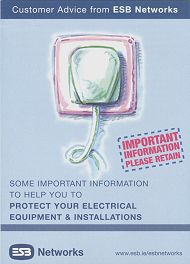|
Although this section borders on the edge of PQ, it is being discussed so often we thought we'd mention it and get it out of the way. "My TV / Hi-Fi / PC / fax / cooker / iron / kettle / etc. was damaged by a spike up the mains, I want compensation!" How presumptuous! Even so, this is the most common 'report' as given by an 'expert' as to the failing of a home appliance. What is becoming even more common is that damage seems to be limited to only 29" wide flat-screen TVs (or whatever the latest technology is offering). Every time I mention this in a PQ training session the response is "now that you mention it..!" - in the event you have not quite seen the tongue-in-cheek, it refers to the fact that most folk claiming for damage will enter the latest available appliance on the insurance form. The ruling is actually quite simple: Protecting a piece of equipment against adverse working conditions This means that I must make sure all the sags, swells, under and over-voltages, spikes and transients that could damage my piece of equipment don't get to damage it. And if it does, well, that's for my account and no-one else's!
In fact, so much so, that the Electricity Supply Board of Ireland (ESB) have issued their own little pamphlet advising users (domestic and industrial) of the 'dangers' of not protecting against mains borne transients, together with some workable solutions from simple "surge protection extension cords" right up to fitting decent transient protection in the distribution boards. These guys get my top vote for having done this! But it would be very unkind of me to be so emphatic about the owner of sensitive goods having to protect them himself without offering a viable, workable solution. Protecting a domestic premises from transient damage is rather easy - at least for 99% of the time (one can never say 'always'!). The solution that has worked for me is a two way one. The first is to ensure the RCD is working properly (or fit one if not there). Then to ensure all plugs on every piece of electronic equipment is a 3-way MOV 'surge arrestor' type (do not settle for 2-way types - they fail miserably at performing what is required). The way these work is should the mains voltage reach an unsafe level the MOVs start conducting, usually non-linearly, and trip the RCD. They are also available for trapping sharp spikes that are as a result of lightning strikes, the current of the spike being limited by the normal house wiring. Should the strike be a 'burner' (repeated strikes, one after the other), then again the RCD notices an 'imbalance' and trips thus removing the house wiring from the mains and as a result protecting the equipment. When it comes to devices like fax machines etc. that have more than one possible entry point (mains and phone line) then it is highly recommended that 'combination' protection units (those that have both the mains and the phone line, antenna, etc. built in) be used. This forces the "bottle neck" method to be adopted. Think of a bottle neck, nothing goes into or out of the bottle without passing the neck. Now if the neck were to represent the lightning protection this would mean that all signals were taken through a common lightning and energy clamping circuit thus ensuring no damaging potential difference between the various parts of a device. The proof of the pudding is I am a radio 'ham' and have had my antenna mast struck 3 times directly, and countless nearby strikes (and to make you really shudder, all my radios were plugged in - including the antennas). I have never had any piece of equipment damaged in my home.
© 30.11.01 |
 SOLUTIONS:
SOLUTIONS: To substantiate this claim; Have a look in TV / Hi-Fi type stores. They sell all sorts of lightning and 'surge' protection. If it was the responsibility of the local electricity company then they would be purchasing such gear and installing it in people's houses, office blocks, etc. Such an idea is a ludicrous one and needs to be stamped out as soon as possible. Why? Because if the local electricity supply company compensates, I land up paying for others' irresponsibility - and that gets up my nose!
To substantiate this claim; Have a look in TV / Hi-Fi type stores. They sell all sorts of lightning and 'surge' protection. If it was the responsibility of the local electricity company then they would be purchasing such gear and installing it in people's houses, office blocks, etc. Such an idea is a ludicrous one and needs to be stamped out as soon as possible. Why? Because if the local electricity supply company compensates, I land up paying for others' irresponsibility - and that gets up my nose!